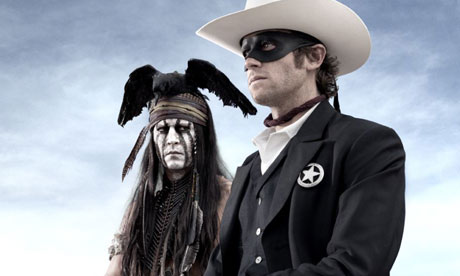 You’ve probably heard about the controversies over Johnny Depp’s portrait of Tonto, in Gore Verbinski’s new film, “The Lone Ranger.” Although portraying a Comanche, the character’s “look” is based on a painting entitled “I am Crow” — and the artist is, yes, a white man (as is the the film’s director [of Polish descent], of course, as well as [to the best that I can figure] the Detroit radio men who first came up with “The Lone Ranger” back in 1932 [first broadcast in 1933]). But beyond that, there’s the general problem of how Hollywood’s depiction of Native Americans continues to reproduce troublesome stereotypes, such as argued in Salon.com‘s recent article on the film:
You’ve probably heard about the controversies over Johnny Depp’s portrait of Tonto, in Gore Verbinski’s new film, “The Lone Ranger.” Although portraying a Comanche, the character’s “look” is based on a painting entitled “I am Crow” — and the artist is, yes, a white man (as is the the film’s director [of Polish descent], of course, as well as [to the best that I can figure] the Detroit radio men who first came up with “The Lone Ranger” back in 1932 [first broadcast in 1933]). But beyond that, there’s the general problem of how Hollywood’s depiction of Native Americans continues to reproduce troublesome stereotypes, such as argued in Salon.com‘s recent article on the film:
 Now, the category “Native American” is itself fraught with complicated, and surprisingly recent, historical and political baggage, inasmuch as it homogenizes diverse and complexly interacting (or not interacting whatsoever) historic groups that predated the arrival of Europeans on this continent (and, of course, who themselves came from somewhere else too). What’s more, it projects backward, into the mists of time, the much later naming of the continent (or do we mean by the term one particular nation within it?), thereby normalizing this place as always having been “the Americas.” (Aside: people in the U.S. sometimes are puzzled to learn that there are no “Native Americans” in Canada.) So precisely how does one properly represent those who today identify with this, or for that matter any, social designation? Better put, how do we determine who decides what counts as proper, since I have no doubt that there’s as many ways to represent this broad grouping of people as there are people who identify with the broad grouping.
Now, the category “Native American” is itself fraught with complicated, and surprisingly recent, historical and political baggage, inasmuch as it homogenizes diverse and complexly interacting (or not interacting whatsoever) historic groups that predated the arrival of Europeans on this continent (and, of course, who themselves came from somewhere else too). What’s more, it projects backward, into the mists of time, the much later naming of the continent (or do we mean by the term one particular nation within it?), thereby normalizing this place as always having been “the Americas.” (Aside: people in the U.S. sometimes are puzzled to learn that there are no “Native Americans” in Canada.) So precisely how does one properly represent those who today identify with this, or for that matter any, social designation? Better put, how do we determine who decides what counts as proper, since I have no doubt that there’s as many ways to represent this broad grouping of people as there are people who identify with the broad grouping.
In posing these “how” questions I am not being so naive as to fail to see the well known issues involved in the politics of representation, especially of/by those who are marginal to centers of power; but what attracts my attention is the ease with which some sides in such disputes authorize their own no less local interests by effectively portraying their representations as universal presentations, as unfettered and coming from nowhere, and thus as the definitive and correct way to depict this or that group and its unified interests.
For the scholar of identification practices, such episodes are therefore important examples of how the competition over identification is fought out in the realm of representation by people on all sides, all with interests, all using techniques (and counter techniques) of representation. For we’re all deeply involved in stereotyping, so its not a matter of overcoming them — after all, “stereotype” is just a euphemism for identification when it’s done by those with whom some “we” disagree, no? So maybe the point is to figure out what interests these or those representations support or contest.
The better, more complicated question, then, is: how can we see the parody (or protest?) picture of Michael Horse that I found through a Facebook friend’s post — Horse is an American actor and member of the Yaqui tribe, who played Tonto himself (in 1981), as well as, among other roles, appearing as a Deputy in “Twin Peaks” — as no less involved in an act of representation as anyone else’s?
 That is, how can we see his photo as a moment that, in the dialectic of its reference to Depp’s Tonto, actively constitutes Horse as Native American (i.e., as not Hollywood — yes, despite him being a Hollywood actor and, apparently, closely enough “connected to the land” as to have farm fowl ready at hand for a photo), rather than merely a passive presentation, a mere expression, of his always and already acquired Native American-ness?
That is, how can we see his photo as a moment that, in the dialectic of its reference to Depp’s Tonto, actively constitutes Horse as Native American (i.e., as not Hollywood — yes, despite him being a Hollywood actor and, apparently, closely enough “connected to the land” as to have farm fowl ready at hand for a photo), rather than merely a passive presentation, a mere expression, of his always and already acquired Native American-ness?
